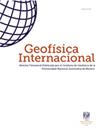Structural Traits of Cuitzeo Lake, Central Mexico, and Areas of Geothermal Potential
IF 0.7
4区 地球科学
Q4 GEOCHEMISTRY & GEOPHYSICS
引用次数: 0
Abstract
Cuitzeo Lake, in the central part of the Trans Mexican Volcanic Belt, is in an extensional region associated with the Cuitzeo graben, where magmatic ascent appears to provide the heat sources for the surface, geothermal manifestations. A profuse distribution of andesitic rocks is observed throughout the study area of 50×50 km2. Gravity and magnetic field 3D inversions are calculated to obtain density and magnetic susceptibility distributions to 7000 m depth, from which we analyze N-S and E-W cross-sections and obtain density and magnetic susceptibility geosurfaces that help characterize anomaly areas of interest. We use satellite-derived gravity and magnetic data in our evaluation, owing to their high-resolution characteristics and uniform coverage of the study area. Analysis initiates with the San Agustín del Maíz region (SAM), exhibiting surface geothermal manifestations, to characterize its density and susceptibility characteristics, then the analysis is extended to the whole study area. Several outcropping, low magnetic susceptibility regions, like the one associated with SAM, are suggested as potential geothermal targets. Density geosurfaces point to two volumes where magmatic material may intrude, coinciding with active geologic faults. The analysis presented here can be extended to neighboring regions in the Cuitzeo Lake area and may constitute a fast, unexpensive exploration methodology in similar geothermal districts.墨西哥中部奎策奥湖的构造特征及地热潜力区
奎策奥湖位于跨墨西哥火山带的中部,是一个与奎策奥地堑相关的伸展区,岩浆上升似乎为地表地热表现提供了热源。在整个50×50 km2的研究区域内观察到大量的安山岩分布。通过计算重力和磁场的三维反演,可以获得7000 m深度的密度和磁化率分布,并从中分析N-S和E-W截面,获得密度和磁化率地面层,从而帮助表征感兴趣的异常区域。我们在评估中使用了卫星获得的重磁数据,因为它们具有高分辨率特征和研究区域的均匀覆盖。首先从地表地热表现明显的San Agustín del Maíz区(SAM)入手,分析其密度和敏感性特征,然后将分析扩展到整个研究区。一些露头的低磁化率区域,如与SAM相关的区域,被认为是潜在的地热目标。密度地质表面指向岩浆物质可能侵入的两个区域,与活跃的地质断层相吻合。本文提出的分析可以推广到奎策湖区的邻近地区,并可能在类似的地热区形成一种快速、廉价的勘探方法。
本文章由计算机程序翻译,如有差异,请以英文原文为准。
求助全文
约1分钟内获得全文
求助全文
来源期刊

Geofisica Internacional
地学-地球化学与地球物理
CiteScore
1.00
自引率
0.00%
发文量
23
审稿时长
>12 weeks
期刊介绍:
Geofísica internacional is a quarterly scientific journal that publishes original papers that contain topics that are interesting for the geophysical community. The journal publishes research and review articles, brief notes and reviews books about seismology, volcanology, spacial sciences, hydrology and exploration, paleomagnetism and tectonic, and physical oceanography.
 求助内容:
求助内容: 应助结果提醒方式:
应助结果提醒方式:


